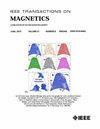用微磁和海森堡模型模拟Bloch点
IF 2.1
3区 工程技术
Q3 ENGINEERING, ELECTRICAL & ELECTRONIC
引用次数: 0
摘要
磁布洛赫点是一种高度受限的磁化结构,经常出现在瞬态自旋动力学过程中。然而,相邻层的相反手性,例如在FeGe双层堆叠中,可以在层界面上稳定这种磁性bp。这些BP结构是亚稳态的,由两个具有相同环流和相反极化的耦合涡(每层一个)组成。每个漩涡都是由相反的Dzyaloshinskii-Moriya相互作用(dmi)来稳定的。从方法学的角度来看,一个悬而未决的问题是,海森堡(HB)模型方法(原子模型)是否用于研究这样的系统,或者是否可以使用计算效率更高的微磁(MM)模型并仍然获得稳健的结果。我们正在模拟和比较用HB和MM方法获得的稳定BP的能量学和动力学。我们发现,稳定BP的MM描述定性地导致与HB描述相同的结果,并且适当的网格离散化比选择的模型起更重要的作用。此外,我们还研究了应用面内场移动BP的动力学,并研究了突然关闭场后的弛豫。与经典涡(CV)相比,耦合涡在BP状态下的进动可以大大减少,这也可能是快速高效设备的一个有趣特征。最近的一项研究表明,托管bp的双层堆栈可以用来存储信息。本文章由计算机程序翻译,如有差异,请以英文原文为准。
Simulating Bloch Points Using Micromagnetic and Heisenberg Models
Magnetic Bloch points (BPs) are highly confined magnetization configurations, which often occur in transient spin dynamics processes. However, opposing chiralities of adjacent layers, for instance, in a FeGe bilayer stack, can stabilize such magnetic BPs at the layer interface. These BP configurations are metastable and consist of two coupled vortices (one in each layer) with the same circulation and opposite polarization. Each vortex is stabilized by opposite sign Dzyaloshinskii-Moriya interactions (DMIs). An open question, from a methodological point of view, is whether the Heisenberg (HB) model approach (atomistic model) is to be used to study such systems or if the computationally more efficient micromagnetic (MM) models can be used and still obtain robust results. We are modeling and comparing the energetics and dynamics of a stable BP obtained using both HB and MM approaches. We find that an MM description of a stable BP leads qualitatively to the same results as the HB description and that an appropriate mesh discretization plays a more important role than the chosen model. Furthermore, we study the dynamics by shifting the BP with an applied in-plane (IP) field and investigating the relaxation after switching the field off abruptly. The precessional motion of coupled vortices in a BP state can be drastically reduced compared to a classical vortex (CV), which may also be an interesting feature for fast and efficient devices. A recent study has shown that a bilayer stack hosting BPs can be used to store information.
求助全文
通过发布文献求助,成功后即可免费获取论文全文。
去求助
来源期刊

IEEE Transactions on Magnetics
工程技术-工程:电子与电气
CiteScore
4.00
自引率
14.30%
发文量
565
审稿时长
4.1 months
期刊介绍:
Science and technology related to the basic physics and engineering of magnetism, magnetic materials, applied magnetics, magnetic devices, and magnetic data storage. The IEEE Transactions on Magnetics publishes scholarly articles of archival value as well as tutorial expositions and critical reviews of classical subjects and topics of current interest.
 求助内容:
求助内容: 应助结果提醒方式:
应助结果提醒方式:


